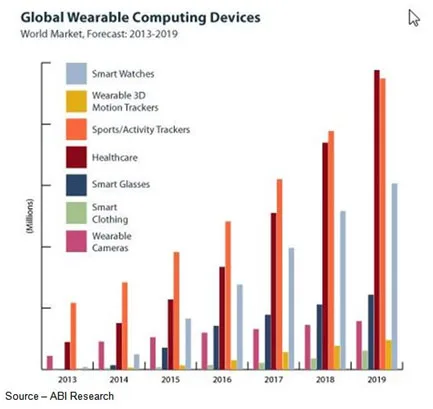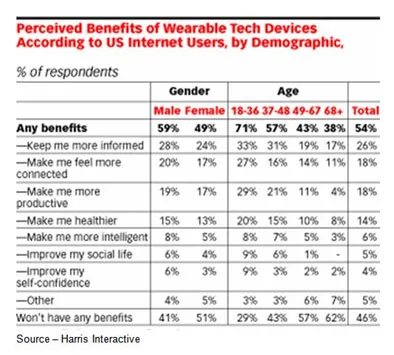Wearable Tech Will Change Lots of Things but You

I’m not sure what I like best about coming back from CES (Consumer Electronics Show): trying to figure out what new insanely reat technology/products are going to be the “gotta have” stuff next Christmas or the first three months of the year at the club and seeing all the folks hell-bent on keeping their New Year’s resolution to lose weight and get back into shape.
This year, both centered on wearables.
There were a lot of real products at the show, but Shapiro’s people wanted you to know that this is the year of the wearables (they hope).
Yeah, they were hot last year.
Depending on who you believe, 71M (Canalys) to 90M (ABI Research) were sold.
And this year, every one of the new club members were there with their new shoes, matching workout outfits and fitness band ready to do battle with age, overeating and months of watching Extreme Weight Loss with a bag of potato chips and couple of sodas.
But soon, they’ll be back home watching Dwayne Johnson push folks to their limit in Wake Up Call, identifying with the pain the participants feel as they enjoy their bag of potato chips, sodas and fitness band.
 Wearables won’t change the way people eat.
Wearables won’t change the way people eat.
But as Mask said, “Ooh, somebody stop me!”
Wearables are more than just for fitness.
They are becoming a key component in healthcare where monitoring and reporting is more important than being a fashion statement.
More than 15M heart rate and activity monitors were sold last year and with an aging population (coupled with the fatburgers consumed), it promises to be an area healthcare professionals want to see expand … rapidly.
Even before their iWatch, Apple and others in the industry have been working with the FDA (Food and Drug Administration) and agencies around the globe that monitor healthcare delivery to develop wearables that help people and work within the letter of the law.
They’re also excellent for monitoring/tracking your kids.
In business, companies are also testing them in delivery and service applications.
 Everything Wearable – Almost everyone agrees that sports and fitness will be the fastest growing wearables segment but the technology is also rapidly changing the healthcare industry. Medical and healthcare applications can benefit both healthcare professionals and consumers.
Everything Wearable – Almost everyone agrees that sports and fitness will be the fastest growing wearables segment but the technology is also rapidly changing the healthcare industry. Medical and healthcare applications can benefit both healthcare professionals and consumers.
Wearables are in that awkward “technology looking for an application” phase – remember what a hit Google Glass was going to be?
While sports, fitness and wellness monitoring are easily identified uses for wearables, other applications that can be enhanced by connectivity will emerge over the next five years to make the devices not only necessary, but almost invisible.
Mary Meeker, of KPCB, emphasized that the benefits and applications for wearables is still a little blurry but the potential is limited only by engineers’ and designers’ applications. She noted that we are still in the early adopter zone but added that it is during this critical phase that newer, better products are developed and new opportunities suddenly emerge.
 Business Opportunities – Wearables technology is just in its infancy. There are opportunities for organizations to focus on developing/improving technology in a number of vital areas such as power consumption, speed and reliable connectivity. KPCB’s Mary Meeker sees the market expanding rapidly over the next five years.
Business Opportunities – Wearables technology is just in its infancy. There are opportunities for organizations to focus on developing/improving technology in a number of vital areas such as power consumption, speed and reliable connectivity. KPCB’s Mary Meeker sees the market expanding rapidly over the next five years.
In the meantime, Harris Interactive found people already see pros and cons with available fitness devices:
- Makes them buff — 67 percent of consumers say wearable tech improves their health and fitness
- Advances careers — one in three said it has helped their career development
- Boosts confidence – more than half said it has helped to aid their self-confidence
- 60 percent said the devices help them feel more in control of their lives
- Aids romance – one in three said that wearable tech “boosts their love lives”
- One in three would be willing to share their personal fitness/health monitoring data with their healthcare provider
- Makes them paranoid – 40 percent said they won’t wear the technology because of privacy concerns
- 62 percent of respondents believe wearable devices should be regulated in some form
- 20 percent call for an outright ban
But Stanley Ipkiss simply commented, “It’s supposed to make you feel powerful.”
 Benefits – While we don’t see wearable technology making an individual smarter, it does have the potential of putting necessary information immediately at your disposal. Used and connected properly, the technology can also improve quality of life.
Benefits – While we don’t see wearable technology making an individual smarter, it does have the potential of putting necessary information immediately at your disposal. Used and connected properly, the technology can also improve quality of life.
Bob O’Donnell, founder and chief analyst at TECHnalysis Research, takes a more measured view of the market.
While basic band wearables have shipped in better numbers than smart bands, the latter will grow faster in the years ahead with tremendous opportunities in the medical and wellness segment.
“The segment is currently considered a relatively small market,” he noted, “but wearables really represent the leading edge of healthcare. The medical and healthcare industry is in a state of dramatic change and it won’t be long that having a computer on your wrist will be very common.”
TECHnalysis Research predicts tepid demand for the near-term with worldwide shipments probably not exceeding 50M units this year.
They project $16B (103M units) in sales by 2018.
 Road Ahead – TECHnalysis Research develops a more conservative approach to the research and projections for wearable technology based on years of market analysis and understanding the many issues that must be overcome before “instant success.”
Road Ahead – TECHnalysis Research develops a more conservative approach to the research and projections for wearable technology based on years of market analysis and understanding the many issues that must be overcome before “instant success.”
O’Donnell says the technology is intriguing at many levels; but to date, manufacturers haven’t been able to develop a clear, compelling value statement for the devices.
As a result, sales have been sharply restricted to early adopters who’ll buy one of damn near anything that’s techie and new.
There are still al lot of challenges associated with the devices including battery life, sensor quality/accuracy, vendor lock-in, aesthetic design and lower prices.
Wearable sports, fitness and wellbeing devices will continue to grow as they become more attractive.
After all, folks like the idea of something that not only looks good but provides so much hope of a slimmer, more handsome/beautiful you.
Especially when you add all those free or paid apps that help you shed pounds by keeping track of the food you eat and show you how many calories you burned walking to/from the car, the elevator, the refrigerator.
Truthfully, they do give you some inspiration to get up and do something to shed those unwanted pounds instead of complaining about your clothes shrinking or clothing manufacturers changing the sizing of their clothing … downward.
Unfortunately, there’s no app that makes people stick to the weight loss and/or exercise program, but they’re working on developing one.
Maybe when wearables are able to communicate with smart clothes that are slowly being introduced, they can talk to each other and let you know you’ve got a problem … yes, you!
Then, even if you don’t pay attention; others on the Internet can tap into your personal information and offer you a better device or discount to the club.
 As Bart said, “You’re lucky we caught these problems now before they cause you some serious trouble.”
As Bart said, “You’re lucky we caught these problems now before they cause you some serious trouble.”
Whether you succeed or fail, console yourself that you are part of what Dr. Neuman said, “We all wear masks … metaphorically speaking.”
# # #